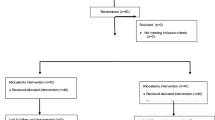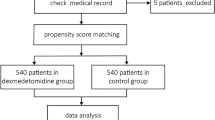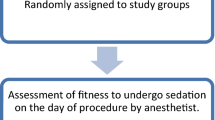Abstract
Introduction
Despite the availability of wide variety of pharmacological agents for dental procedural sedation, there has always been a continuous search for newer sedative agents. Dexmedetomidine is a newer sedative agent for provision of short-term sedation (<24 h) in adult patients in the intensive care unit setting. It is a selective α2 adrenergic receptor agonist. The reports on off-label use of this drug in a variety of settings for invasive and non invasive procedural sedation have provided encouraging results.
Material and methods
The present paper reports a pilot study observing clinical efficacy of the newer drug dexmedetomidine in patients undergoing office based sliding genioplasty for correction of facial asymmetry. Subjects were sedated with dexmedetomidine with a loading dose of 0.5 mcg/kg over 10 min followed by a continuous infusion dose of 0.1 mcg/kg/h, the recovery process was observed for 60 min after the dexmedetomidine infusion was stopped. The patients were observed pre operatively, intra operatively (every 10 min) and postoperatively for the following parameters—oxygen saturation (SpO2), mean arterial pressure (MAP), heart rate (HR), and Ramsay sedation score (RSS), respiratory rate, pain scale.
Similar content being viewed by others
References
Locker D (2003) Psychological consequences of dental fear and anxiety. Community Dent Oral Epidemiol 31(2):144–151
Chanpong B, Haas DA, Locker D (2005) Need and demand for sedation or general anesthesia in dentistry: a national survey of the Canadian population. Anesth Prog 52(1):3–11
Spear SL, Mansuer ME, Kawamoto HK (1987) Sliding genioplasty as a local anesthesia outpatient procedure: a prospective two center trial. Plast Reconstr Surg 80:55–63
Van Sickels JE, Tiner BD (1992) Cost of genioplasty under deep intravenous sedation in a private office versus general anesthesia in an outpatient surgical center. J Oral Maxillofac Surg 50:687–690
Konovitch JW (1997) Intravenous sedation for aesthetic surgery. In: Aston SJ, Beasley RW, Thorne CHM (eds) Grabb and Smith’s plastic surgery, 5th edn. Lippincott-Raven, Philadelphia
Raffaini M, Hernandez AF, Ghilardi R, Garcia LA (2002) The sagittal mandibular osteotomy under local anesthesia and intravenous sedation: four years of multicenter experience. Int J Adult Orthodon Orthognath Surg 17(4):267–271
Nathan JE, West MS (1987) Comparison of chloral hydratehydroxyzine with and without meperidine for management of difficult pediatric patients. J Dent Child 54:437–443
Sams DR, Thorton JB, Wright JM (1992) The assessment of two oral sedation drug regimens in pediatric dental patients. J Dent Child 59:306–312
Littman RS, Kotra JA, Verga RA, Berkowitz RJ, Ward DS (1998) Chloral hydrate sedation. The additive sedative and respiratory depressant effect of nitrous oxide. Anesth Analg 86:724–728
Shapira J, Holan G, Botzer E, Kupletzky A, Tal E, Fuks A (1996) The effectiveness of midazolam and hydroxyzine as sedative agents for young pediatric dental patients. J Dent Child 63:421–425
Roelofse AJ, Joubert VDJJ, Roelofse RGP (1996) A double-blind randomized comparison of midazolam alone and midazolam combined with ketamine for sedation of pediatric dental patients. J Oral Maxillofac Surg 54:238–844
Roelofse AJ, Shipton AE, de la Harpe JC, Blignaut JR (2004) Intranasal sufentanil/midazolam versus ketamine/midazolam for analgesia/sedation in the pediatric population prior to undergoing multiple dental extractions under general anesthesia: a prospective, double-blind, randomized comparison. Anesth Prog 51:114–121
Arya VS, Damle SG (2002) Comparative evaluation of midazolam and propofol as intravenous sedative agents in the management of unco-operative children. J Indian Soc Pedod Prev Dent 20:6–8
Mittal N, Goyal A, Gauba K, Kapur A, Jain K (2013) A double blind randomized trial of ketofol versus propofol for endodontic treatment of anxious pediatric patients. J Clin Pediatr Dent 37(4):415–420
Kapur A, Chawla SH, Goyal A, Gauba K, Bhardwaj N (2004) Efficacy and acceptabilty of oral-transmucosal midazolam as a conscious sedation agent in pre-school children. J Indian Soc Pedod Prev Dent 22:109–113
Damle SG, Gandhi M, Laheri V (2008) Comparison of oral ketamine and oral midazolam as premedication in pediatric dental patients. J Indian Soc Pedod Prev Dent 26:97e100
Knoff SB, Van Sickels JE, Holmgeen WC (1991) Outpatient orthognathic surgery: criteria and review of cases. J Oral Maxillofac Surg 49:117–121
Lupori JP, Van Sickels JE, Holmgreen WC (1997) Outpatient orthognathic surgery: review of 205 cases. J Oral Maxillofac Surg 55:558–563
Dann JJ (1998) Outpatient oral and maxillofacial surgery: transition to a setting and outcome of the first 200 cases. J Oral Maxillofac Surg 56:572–577
Blakey GH, White RP (1999) Bilateral sagittal split osteotomies in ambulatory care setting. Semin Orthod 5:241–243
Fan TW, Ti LK, Islam I (2013) Comparison of dexmedetomidine and midazolam for conscious sedation in dental surgery monitored by bispectral index. Br J Oral Maxillofac Surg 51:428–433
Ragab A, ElShamaa H, Ibrahim M (2013) Dexmedetomidine, morphine, propofol vs midazolam, morphine, propofol for conscious sedation in rhinoplasty under local anaesthesia. A prospective, randomized study. Egypt J Anaesth 29:181–187
Nelson LE (2003) The alpha 2-adrenoceptor agonist dexmedetomidine converges on an endogenous sleep-promoting pathway to exert its sedative effects. Anesthesiology 98:428–436
Doze VA, Chen BX, Tinklenberg JA, Segal IS, Maze M (1990) Pertussis toxin and 4-aminopyridine differentially affect the hypnotic–anaesthetic action of dexmedetomidine and pentobarbital. Anesthesiology 73:304–307
Sullivan AF, Kalso EA, McQuay HJ, Dickenson AH (1992) The antinociceptive actions of dexmedetomidine on dorsal horn neuronal responses in the anaesthetized rat. Eur J Pharmacol 215:127–133
Taniyama K, Oda H, Okawa K, Himeno K, Shikanai K, Shibutani T (2009) Psychosedation with dexmedetomidine hydrochloride during minor oral surgery. Anesth Prog 56:75–80
Hall JE, Uhrich TD, Barney JA et al (2000) Sedative, amnestic, and analgesic properties of small-dose dexmedetomidine infusions. Anesth Analg 90:699–705
Doze VA, Chen BX, Maze M (1898) Dexmedetomidine produces a hypnotic–anesthetic action in rats via activation of central alpha-2 adrenoceptors. Anesthesiology 71:75–79
Karlsson BR, Forsman M, Roald OK et al (1990) Effect of dexmedetomidine, a selective and potent alpha 2-agonist, on cerebral blood flow and oxygen consumption during halothane anesthesia in dogs. Anesth Analg 71:125–129
Prielipp RC, Wall MH, Tobin JR et al (2002) Dexmedetomidine induced sedation in volunteers decreases regional and global cerebral blood flow. Anesth Analg 95:1052–1059
Guidelines for office based anaesthesia by committee of ambulatory surgical care. Approved by ASA, House of Delegates, October 13, 1999. www.asahq.org. Accessed on 10 Oct 2014
Author information
Authors and Affiliations
Corresponding author
Rights and permissions
About this article
Cite this article
Kumar, P., Priya, K., Kirti, S. et al. Dexmedetomidine Supported Office Based Genioplasty: A Pilot Study. J. Maxillofac. Oral Surg. 14, 750–753 (2015). https://doi.org/10.1007/s12663-014-0733-6
Received:
Accepted:
Published:
Issue Date:
DOI: https://doi.org/10.1007/s12663-014-0733-6




